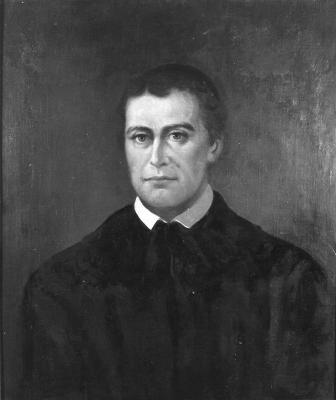President: 1812-1817
Fr. John Grassi, S.J., served as Georgetown's ninth president from 1812-1817. Fr. Grassi's accomplishments as president included obtaining a congressional charter and significantly expanding enrollment; he was considered Georgetown's "Second Founder" in recognition of his achievements.
Early Jesuit and academic career
John Grassi was born in Bergamo, Italy in 1775, and in 1799, he entered the Society of Jesus at Colorno in Northern Italy. With the 1773 papal ban on the Jesuits still in effect, Fr. Grassi and the other Italian novices studied in Russia. Following his ordination, Fr. Grassi became rector of the College of Nobles at Polocz. In 1805, Fr. Grassi was ordered to accompany a mission to China, but after the Jesuits’ efforts to reach China were repeatedly thwarted by the East India Trading Company, they settled at Stonyhurst College in England. There Fr. Grassi studied science and English, before he was ordered to go to America in 1810.1
Fr. Grassi spent a year teaching Italian and Spanish at Georgetown before the Jesuit superior general appointed Fr. Grassi both head of the Maryland mission and president of Georgetown. Prior presidents had been named by either John Carroll or the directors, but while Carroll decried the superior general’s authority to make such an appointment, he urged the directors to respect the appointment. Fr. Grassi became Georgetown’s ninth president on October 1, 1812, succeeding Fr. Francis Neale.2
Administrative issues
Fr. Grassi’s initially balked at Georgetown’s administrative structure. Fr. Francis Neale had been elected Vice-President, a position that included management and control over Georgetown’s everyday operations. Fr. Grassi protested, arguing that he would be subject to the authority of the Jesuits and not the Corporation of Roman Catholic Clergyman and their trustees who controlled Georgetown’s finances. Eventually, after assurances from both John Carroll and Fr. Neale that Georgetown would be ceded to the Jesuits after the Order was fully reestablished, Fr. Grassi accepted this arrangement, as he had more pressing problems to attend to.3
Tuition and curriculum reforms
The Georgetown Fr. Grassi inherited was in a rough state. With only ten boarding students and a few day students to whom he referred to as “a crew of blackguard youths and boys,” Fr. Grassi lamented his “melancholy situation, compelled to be a sorrowful spectator of the miserable state of this College.”4 Fr. Grassi knew that the tuition of the few students who paid the full $220 rate would never cover Georgetown’s operating costs which included free tuition for students pursuing religious vocations. Facing a $3,000 budget deficit, Fr. Grassi cut tuition and fees to $125 to increase enrollment. At $125, Georgetown offered a competitive rate, with St. John’s College in Annapolis charging $159 and Mount St. Mary’s College in Emmitsburg charging $400. Enrollment rose from fifty-six students and nineteen boarders in the fall of 1811 to 129 students and ninety-five boarders in 1815. By 1817, 90% of Georgetown’s students lived on campus.5
Georgetown’s curriculum was expanded and new attention given to the sciences during Fr. Grassi’s tenure. In addition to his presidential duties, Fr. Grassi taught algebra, mensuration (measurement), arithmetic, and astronomy using tools he had brought with him from Stonyhurst. He had wooden models built to demonstrate the Copernican solar system and mechanical and hydraulic principles, calculated eclipses and altitudes, and even launched a balloon from the college grounds.6
War of 1812
Fr. Grassi guided Georgetown during a period of national turmoil. When the War of 1812 came to Washington, DC in August of 1814, summer boarders watched the Capitol burn from their rooms at Georgetown. The next day Georgetown prepared for its own pillaging, hiding sacred vessels and plates and praying in the chapel. Fortunately, the British withdrew, and the College opened its fall term as scheduled with five priests, two scholastics, nine brothers, nine secular masters and tradesmen, twelve servants, and sixty-five students clad in the Georgetown uniform of a blue coat and pant with yellow buttons and a red waistcoat.7
Georgetown's charter
The summer of 1814 also saw the long-awaited restoration of the Society of Jesus by the decree of Pope Pius VII. With the Society of Jesus restored, Fr. Grassi began to seek a Congressional charter for Georgetown. With the assistance of Georgetown’s first student, William Gaston, who had been elected to the House of Representatives in 1813, Congress granted Georgetown’s petition, and President Madison signed it into law on March 1, 1815.8
Legacy
For his improvements of Georgetown’s student body, faculty, and national stature, Fr. Grassi earned the nickname, “Georgetown’s Second Founder.” Even Archbishop Carroll remarked, “Fr. Grassi has revived the College of Georgetown, which has received great improvement in the number of students and course of studies.”9 On September 10, 1817 Fr. Grassi’s term ended, and he was succeeded by Fr. Benedict Joseph Fenwick.
- 1Horgan, Paul. “Georgetown’s Second Founder: Giovanni Antonio Grassi, S.J.” Georgetown University Alumni Magazine, Vol 17, No. 2, Fall 1964, pp.8-9.
- 2Emmett Curran, Robert. “The Bicentennial History of Georgetown University: From Academy to University, 1789–1889.” 1993, pp.64-65.
- 3Id. at p.65.
- 4Georgetown’s Second Founder: Giovanni Antonio Grassi, S.J.” p.8.
- 5“The Bicentennial History of Georgetown University: From Academy to University, 1789–1889.” pp.66-67.
- 6Schlafly, Daniel. "Chapter 20: The "Russian" Society and the American Jesuits: Giovanni Grassi's Crucial Role" 2015, pp.361-62.
- 7Georgetown’s Second Founder: Giovanni Antonio Grassi, S.J.” p.12.
- 8The Bicentennial History of Georgetown University: From Academy to University, 1789–1889.” p.75.
- 9Georgetown’s Second Founder: Giovanni Antonio Grassi, S.J.” p.12.


